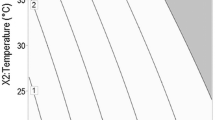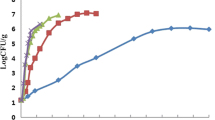Abstract
The objective of this study was to develop a model of the growth of Listeria monocytogenes in pork untreated or treated with low concentration electrolyzed water (LcEW) and strong acid electrolyzed water (SAEW), as a function of temperature. The experimental data obtained under different temperatures (4, 10, 15, 20, 25, and 30°C) were fitted into the modified Gompertz model to generate the growth parameters including specific growth rate (SGR) and lag time (LT) with high coefficients of determination (R2 >0.97). The obtained SGR and LT were employed to develop square root models to evaluate the effects of storage temperature on the growth kinetics of L. monocytogenes in pork. The values of bias factor (0.924–1.009) and accuracy factor (1.105–1.186), which were regarded as acceptable, demonstrated that the obtained models could provide good and reliable predictions and be suitable for the purpose of microbiological risk assessment of L. monocytogenes in pork.
Similar content being viewed by others
References
Ramaswamy V, Cresence VM, Rejitha JS, Lekshmi MU, Dharsana KS, Prasad SP, Vijila HM. Listeria—review of epidemiology and pathogenesis. J. Microbiol. Immunol. 40: 4–13 (2007)
Mead PS, Slutsker L, Dietz V, McCaig LF, Bresee JS, Shapiro C, Griffin PM, Tauxe V. Food-related illness and death in the United States. Emerg. Infect. Dis. 5: 607–625 (1999)
Shimizu Y, Hurusawa T. Antiviral, antibacterial, and antifungal actions of electrolyzed oxidizing water through electrolysis. Dental J. 37: 1055–1062 (1992)
Huang YR, Hung YC, Hsu SY, Huang YW, Hwang DF. Application of electrolyzed water in the food industry. Food Control 19: 329–345 (2008)
Fabrizio KA, Cutter CN. Application of electrolyzed oxidizing water to reduce Listeria monocytogenes on ready-to-eat meats. Meat Sci. 71: 327–333 (2005)
Kim C, Hung YC, Brackett RE. Efficacy of electrolyzed oxidizing (EO) and chemically modified water on different types of foodborne pathogens. Int. J. Food Microbiol. 61: 199–207 (2000)
Ozer NP, Demirci A. Electrolyzed oxidizing water treatment for decontamination of raw salmon inoculated with Escherichia coli O157:H7 and Listeria monocytogenes Scott A and response surface modeling. J. Food Eng. 72: 234–241 (2006)
Park H, Hung YC, Brackett RE. Antimicrobial effect of electrolyzed water for inactivating Campylobacter jejuni during poultry washing. Int. J. Food Microbiol. 72: 77–83 (2002)
Venkitanarayanan KS, Ezeike GO, Hung YC, Doyle MP. Efficacy of electrolyzed oxidizing water for inactivating Escherichia coli O157:H7, Salmonella enteritidis, and Listeria monocytogenes. Appl. Environ. Microb. 65: 4276–4279 (1999)
Len SV, Hung YC, Erickson MC, Kim C. Ultraviolet spectrophotometric characterizations and bacterial properties of electrolyzed oxidizing water as influenced by amperage and pH. J. Food Protect. 63: 1534–1537 (2000)
Rahman SME, Ding T, Oh DH. Effectiveness of low concentration electrolyzed water to inactivate foodborne pathogens under different environmental conditions. Int. J. Food Microbiol. 139: 147–153 (2010)
Wang J, Rahman SME, Ding T, Oh DH. Optimization of inactivation of Staphylococcus aureus by low concentration electrolyzed water using response surface methodology. Food Sci. Biotechnol. 20: 1367–1371 (2011)
Issa-Zacharia A, Kamitani Y, Tiisekwa A, Morita K, Iwasaki K. In vitro inactivation of Escherichia coli, Staphylococcus aureus, and Salmonella spp. using slightly acidic electrolyzed water. J. Biosci. Bioeng. 110: 308–313 (2010)
Water Review Technical Briefs. Available from: www.wqa.org/WQIS/Improve-WQ-Disinfect.html. Accessed Jul. 09, 2011.
Guentzel JL, Lam KL, Callan MA, Emmons SA, Dunham VL. Reduction of bacteria on spinach, lettuce, and surfaces in food service areas using neutral electrolyzed oxidizing water. Food Microbiol. 25: 36–41 (2008)
Raloff J. Food for thought: Global food trends. Science News (2003) Available from: http://www.sciencenews.org/view/generic/id/3902/title/Food_for_Thought__Global_Food_Trends. Accessed Sep. 16, 2011.
Ding T, Wang J, Oh DH. Modelling the effect of temperature and relative humidity on the growth of Staphylococcus aureus on fresh-cut spinach using a user-friendly software. Food Sci. Biotechnol. 20: 1593–1597 (2011)
Rahman SME, Ding T, Oh DH. Inactivation effect of newly developed low concentration electrolyzed water and other sanitizers against microorganisms on spinach. Food Control 21: 1383–1387 (2010)
Ding T, Rahman SME, Oh DH. Inhibitory effects of low concentration electrolyzed water and other sanitizers against foodborne pathogens on oyster mushroom. Food Control 22: 318–322 (2011)
Allende A, Martinez B, Selma V, Gil MI, Suarez JE, Rodriguez A. Growth and bacteriocin production by lactic acid bacteria in vegetable broth and their effectiveness at reducing Listeria monocytogenes in vitro and in fresh-cut lettuce. Food Microbiol. 24: 759–766 (2007)
Ding T, Rahman SME, Purev U, Oh DH. Modeling of Escherichia coli O157:H7 growth at various storage temperatures on beef treated with electrolyzed oxidizing water. J. Food Eng. 97: 497–503 (2010)
Sheen S, Hwang CA, Juneja VK. Modeling the impact of chlorine on the behavior of Listeria monocytogenes on ready-to-eat meats. Food Microbiol. 28: 1095–1100 (2011)
te-Giffel MC, Zwietering MH. Validation of predictive models describing the growth of Listeria monocytogenes. Int. J. Food Microbiol. 46: 135–149 (1999)
Ross T. Predictive Food Microbiology Models in the Meat Industry (MSRC.003). Meat and Livestock, Australia. p. 196 (1999)
Ross T, Dalgaard P, Tienungoon S. Predictive modeling of the growth and survival of Listeria in fishery products. Int. J. Food Microbiol. 62: 231–245 (2000)
Author information
Authors and Affiliations
Corresponding author
Rights and permissions
About this article
Cite this article
Wang, J., Rahman, S.M.E., Park, MS. et al. Modeling the response of Listeria monocytogenes at various storage temperatures in pork with/without electrolyzed water treatment. Food Sci Biotechnol 21, 1549–1555 (2012). https://doi.org/10.1007/s10068-012-0206-y
Received:
Revised:
Accepted:
Published:
Issue Date:
DOI: https://doi.org/10.1007/s10068-012-0206-y




